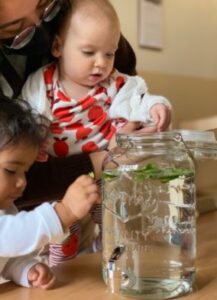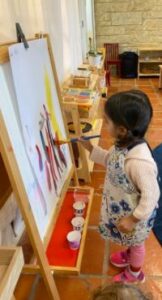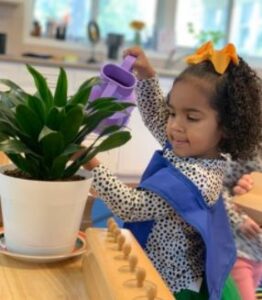
Reflection by Ms. Milinh, Head of School at our Cantera Montessori location.
As we gear up being thankful and thinking about Christmas and all the toys and “stuff” that comes with it—sometimes less is more, there is a beauty in simplicity.
Think about how you feel when your home is a mess—unmade beds, toys everywhere, dust on the floors, grimy dishes in the sink. Compare that to when your home is clean and tidy, with everything in its place.
 Does one scenario bring on stressful feelings, while the other makes you feel calm and settled? Even if we don’t consciously realize it, our environments affect us. Children are no exception and are in fact more sensitive to what’s around them than adults.
Does one scenario bring on stressful feelings, while the other makes you feel calm and settled? Even if we don’t consciously realize it, our environments affect us. Children are no exception and are in fact more sensitive to what’s around them than adults.
With the holidays coming and gifts lists are being made – let’s take a step back and be mindful of what kind of importance are we emphasizing on “stuff”.
We Montessorians take this to heart, believing that the child, the teacher, and the environment all work together to form a “learning triangle.” We believe that when an environment is set up appropriately, it can help a child develop independence, coordination, concentration, and an internal sense of order, as well as support well-being and social and academic achievement.
Montessori guides take great care in the preparation of their classroom environments, guided in large part by the idea of simplicity. Everything in the classroom has a purpose and a place where it rests when it is not in use.
There is an intuitive sense of order that makes it easy for the children to navigate the space and to clean up after themselves successfully. Teachers keep the environment fresh and engaging by observing how children respond to the environment and changing things as needed.
Children don’t stop being sensitive to their environment when they leave the classroom. At home, parents can create a similarly supportive space by also using simplicity as a touchstone.
A simple home environment can support your child’s concentration, curiosity, and sense of calm. Simplifying also invites connection between family members, which may help decrease conflict and increase cooperation. Who wouldn’t want more present and connected family time?
Here are a few guidelines to help guide our thoughts around gifts/toys/stuff around the holidays.
Children have a chance to enjoy what they have when there is less of it around. When you tuck away 30%–50% of most children’s toys (in a closet, garage, or other storage system), you may find they actually become more interested in what is on their shelves.

This leads to longer periods of concentration, easier cleanup, greater independence, and less tension among family members about messy spaces. Think about quality rather than quantity.
Paring down may be easier than you think. Regularly throw away toys that break and donate gently used items that your child has truly outgrown. If you do this with your own belongings in your child’s presence, you can model nonattachment.
Practice this on a regular basis with your child; you may find that letting go becomes normal behavior. With the holidays coming, maybe consider donating to other organizations or families who are more in need.
What to do with the half of your children’s possessions you’ve tucked away? One way to delight your children while also simplifying is to create a toy rotation system. Every few weeks, rotate the toys that are “out” in the space, replacing them with the ones you put in storage.
This creates a burst of new interest in the things that are available, even when they have been in your child’s possession for years. Follow your child’s cues to know when it is time to switch. When you notice your child losing interest in or getting restless with the “new” toys, it’s time to rotate again.
Once you get into a rotating routine, your child will likely let you know when she wants to rotate for some fresh items! Your child will let you know if a certain toy or activity needs to be available all the time.
Choose toys that will engage rather than entertain. If we want our children to develop concentration, we need to surround them with things that encourage concentration. In general, anything with batteries or a screen is grabbing your child’s passive attention. He can play with these things all day and still not learn. Even toys with batteries that claim to be educational will do far less for your child’s academic success than some good old-fashioned manipulatives and activities.

Seek out toys, games, and activities that are open-ended and invite curiosity, creativity, voluntary attention, and problem solving. Blocks, puzzles, water works, pegboards, books, puppets, and natural objects that can be counted and sorted are a few options.
Think about how lovely it is when you enter a place that is simple, orderly, and beautiful. Something in you relaxes. Adults seek out these kinds of places to help them access creative flow and spiritual insights, or to rest and rejuvenate.
Bring a little of that wonderful energy into your home by displaying toys and activities in a way that is enticing and has a clear sense of order. Your children will respond to this simple beauty, just as they do in their classrooms.
And always remember presence is more important than presents all year long. Happy Holidays to all our wonderful families.